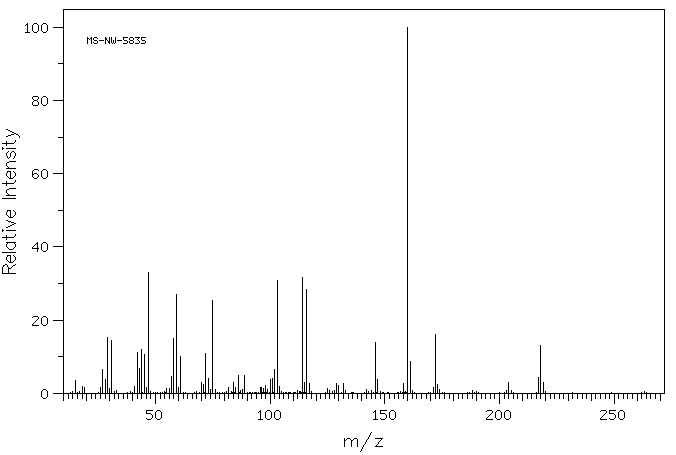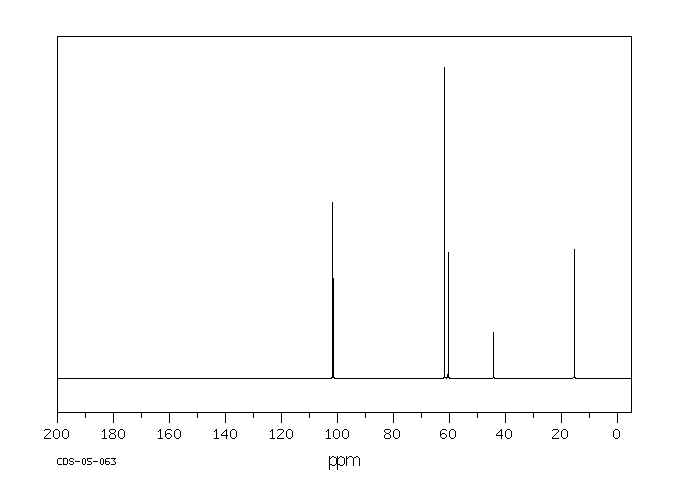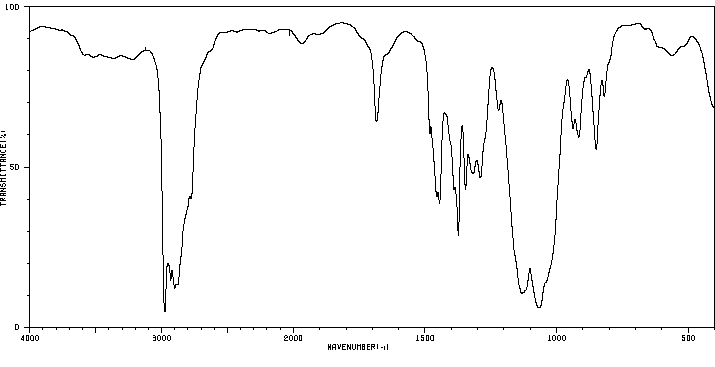2,2-甲基亚氨基双(乙醛二乙基乙缩醛) | 6948-86-3
中文名称
2,2-甲基亚氨基双(乙醛二乙基乙缩醛)
中文别名
——
英文名称
N,N-bis(2,2-diethoxyethyl)methyl amine
英文别名
bis-(2,2-diethoxy-ethyl)-methyl-amine;Bis-(2,2-diaethoxy-aethyl)-methyl-amin;Methyl-bis-(β.β-diaethyl-diaethoxy-aethyl)-amin;Methyl-diacetalyl-amin;N,N-bis(2,2-diethoxyethyl)methylamine;N-Methyl-diacetalylamin;N-(2,2-diethoxyethyl)-2,2-diethoxy-N-methylethanamine
CAS
6948-86-3
化学式
C13H29NO4
mdl
——
分子量
263.378
InChiKey
DPLOXPRJCFWURN-UHFFFAOYSA-N
BEILSTEIN
——
EINECS
——
-
物化性质
-
计算性质
-
ADMET
-
安全信息
-
SDS
-
制备方法与用途
-
上下游信息
-
文献信息
-
表征谱图
-
同类化合物
-
相关功能分类
-
相关结构分类
物化性质
-
沸点:220-222 °C/244 mmHg(lit.)
-
密度:0.945 g/mL at 25 °C(lit.)
-
闪点:60 °C
计算性质
-
辛醇/水分配系数(LogP):1.5
-
重原子数:18
-
可旋转键数:12
-
环数:0.0
-
sp3杂化的碳原子比例:1.0
-
拓扑面积:40.2
-
氢给体数:0
-
氢受体数:5
安全信息
-
危险等级:3.2
-
危险品标志:Xi
-
安全说明:S24/25
-
危险类别码:R20/21/22
-
海关编码:2922199090
-
包装等级:III
-
危险类别:3.2
-
危险品运输编号:UN 1993
SDS
| Name: | N N-Bis-(2 2-=Diethoxyethyl)-Methylamine 97% Material Safety Data Sheet |
| Synonym: | None known |
| CAS: | 6948-86-3 |
Synonym:None known
Section 2 - COMPOSITION, INFORMATION ON INGREDIENTS
| CAS# | Chemical Name | content | EINECS# |
| 6948-86-3 | N, N-Bis-(2,2-Diethoxyethyl)-Methylami | 97 | 230-115-3 |
Risk Phrases: 10 20/21/22
Section 3 - HAZARDS IDENTIFICATION
EMERGENCY OVERVIEW
Flammable. Harmful by inhalation, in contact with skin and if swallowed.
Potential Health Effects
Eye:
May cause eye irritation. May cause chemical conjunctivitis and corneal damage.
Skin:
May cause irritation and dermatitis. May cause cyanosis of the extremities.
Ingestion:
May cause gastrointestinal irritation with nausea, vomiting and diarrhea. The toxicological properties of this substance have not been fully investigated. Ingestion of large amounts may cause CNS depression.
Inhalation:
The toxicological properties of this substance have not been fully investigated. Aspiration may lead to pulmonary edema. Vapors may cause dizziness or suffocation. May cause burning sensation in the chest.
Chronic:
No information found.
Section 4 - FIRST AID MEASURES
Eyes: Flush eyes with plenty of water for at least 15 minutes, occasionally lifting the upper and lower eyelids. Get medical aid.
Skin:
Get medical aid. Flush skin with plenty of water for at least 15 minutes while removing contaminated clothing and shoes. Wash clothing before reuse.
Ingestion:
Never give anything by mouth to an unconscious person. Get medical aid. Do NOT induce vomiting. If conscious and alert, rinse mouth and drink 2-4 cupfuls of milk or water.
Inhalation:
Remove from exposure and move to fresh air immediately. If not breathing, give artificial respiration. If breathing is difficult, give oxygen. Get medical aid.
Notes to Physician:
Section 5 - FIRE FIGHTING MEASURES
General Information:
As in any fire, wear a self-contained breathing apparatus in pressure-demand, MSHA/NIOSH (approved or equivalent), and full protective gear. Vapors may form an explosive mixture with air.
Vapors can travel to a source of ignition and flash back. During a fire, irritating and highly toxic gases may be generated by thermal decomposition or combustion. Will burn if involved in a fire. Use water spray to keep fire-exposed containers cool. Water may be ineffective. Material is lighter than water and a fire may be spread by the use of water. Containers may explode in the heat of a fire.
Flammable liquid and vapor. Vapors may be heavier than air. They can spread along the ground and collect in low or confined areas.
Extinguishing Media:
For small fires, use dry chemical, carbon dioxide, water spray or alcohol-resistant foam. For large fires, use water spray, fog, or alcohol-resistant foam. Use water spray to cool fire-exposed containers. Water may be ineffective. Do NOT use straight streams of water.
Section 6 - ACCIDENTAL RELEASE MEASURES
General Information: Use proper personal protective equipment as indicated in Section 8.
Spills/Leaks:
Absorb spill with inert material (e.g. vermiculite, sand or earth), then place in suitable container. Avoid runoff into storm sewers and ditches which lead to waterways. Clean up spills immediately, observing precautions in the Protective Equipment section. Remove all sources of ignition. Use a spark-proof tool. Provide ventilation. A vapor suppressing foam may be used to reduce vapors.
Section 7 - HANDLING and STORAGE
Handling:
Wash thoroughly after handling. Use with adequate ventilation.
Ground and bond containers when transferring material. Use spark-proof tools and explosion proof equipment. Avoid contact with eyes, skin, and clothing. Empty containers retain product residue, (liquid and/or vapor), and can be dangerous. Keep container tightly closed. Keep away from heat, sparks and flame. Avoid ingestion and inhalation. Do not pressurize, cut, weld, braze, solder, drill, grind, or expose empty containers to heat, sparks or open flames.
Storage:
Keep away from heat, sparks, and flame. Keep away from sources of ignition. Store in a tightly closed container. Store in a cool, dry, well-ventilated area away from incompatible substances.
Flammables-area.
Section 8 - EXPOSURE CONTROLS, PERSONAL PROTECTION
Engineering Controls:
Facilities storing or utilizing this material should be equipped with an eyewash facility and a safety shower. Use adequate general or local explosion-proof ventilation to keep airborne levels to acceptable levels.
Exposure Limits CAS# 6948-86-3: Personal Protective Equipment Eyes: Wear appropriate protective eyeglasses or chemical safety goggles as described by OSHA's eye and face protection regulations in 29 CFR 1910.133 or European Standard EN166.
Skin:
Wear appropriate protective gloves to prevent skin exposure.
Clothing:
Wear appropriate protective clothing to prevent skin exposure.
Respirators:
A respiratory protection program that meets OSHA's 29 CFR 1910.134 and ANSI Z88.2 requirements or European Standard EN 149 must be followed whenever workplace conditions warrant respirator use.
Section 9 - PHYSICAL AND CHEMICAL PROPERTIES
Physical State: Liquid
Color: colorless
Odor: amine-like
pH: Not available.
Vapor Pressure: Not available.
Viscosity: Not available.
Boiling Point: 222 deg C @ 244.00mmHg
Freezing/Melting Point: Not available.
Autoignition Temperature: Not available.
Flash Point: 60 deg C ( 140.00 deg F)
Explosion Limits, lower: Not available.
Explosion Limits, upper: Not available.
Decomposition Temperature:
Solubility in water:
Specific Gravity/Density: .9450g/cm3
Molecular Formula: C13H29NO4
Molecular Weight: 263.38
Section 10 - STABILITY AND REACTIVITY
Chemical Stability:
Stable under normal temperatures and pressures.
Conditions to Avoid:
Incompatible materials, ignition sources, excess heat, strong oxidants.
Incompatibilities with Other Materials:
Oxidizing agents.
Hazardous Decomposition Products:
Nitrogen oxides, carbon monoxide, irritating and toxic fumes and gases, carbon dioxide.
Hazardous Polymerization: Has not been reported
Section 11 - TOXICOLOGICAL INFORMATION
RTECS#:
CAS# 6948-86-3 unlisted.
LD50/LC50:
Not available.
Carcinogenicity:
N, N-Bis-(2,2-Diethoxyethyl)-Methylamine - Not listed by ACGIH, IARC, or NTP.
Section 12 - ECOLOGICAL INFORMATION
Section 13 - DISPOSAL CONSIDERATIONS
Dispose of in a manner consistent with federal, state, and local regulations.
Section 14 - TRANSPORT INFORMATION
IATA
Shipping Name: FLAMMABLE LIQUID, N.O.S.*
Hazard Class: 3
UN Number: 1993
Packing Group: II
IMO
Shipping Name: FLAMMABLE LIQUID, N.O.S.
Hazard Class: 3.2
UN Number: 1993
Packing Group: II
RID/ADR
Shipping Name: FLAMMABLE LIQUID, N.O.S.
Hazard Class: 3
UN Number: 1993
Packing group: II
Section 15 - REGULATORY INFORMATION
European/International Regulations
European Labeling in Accordance with EC Directives
Hazard Symbols: XN
Risk Phrases:
R 10 Flammable.
R 20/21/22 Harmful by inhalation, in contact with
skin and if swallowed.
Safety Phrases:
S 9 Keep container in a well-ventilated place.
S 16 Keep away from sources of ignition - No
smoking.
S 24/25 Avoid contact with skin and eyes.
S 28A After contact with skin, wash immediately with
plenty of water.
S 33 Take precautionary measures against static
discharges.
S 37 Wear suitable gloves.
S 45 In case of accident or if you feel unwell, seek
medical advice immediately (show the label where
possible).
WGK (Water Danger/Protection)
CAS# 6948-86-3: No information available.
Canada
None of the chemicals in this product are listed on the DSL/NDSL list.
CAS# 6948-86-3 is not listed on Canada's Ingredient Disclosure List.
US FEDERAL
TSCA
CAS# 6948-86-3 is not listed on the TSCA inventory.
It is for research and development use only.
SECTION 16 - ADDITIONAL INFORMATION
N/A
反应信息
-
作为反应物:描述:顺式-1,2-二羟甲基乙烯 、 2,2-甲基亚氨基双(乙醛二乙基乙缩醛) 在 对甲苯磺酸 作用下, 以40%的产率得到1-(4,7-dihydro-1,3-dioxepin-2-yl)-N-(4,7-dihydro-1,3-dioxepin-2-ylmethyl)-N-methylmethanamine参考文献:名称:Tahnh, Naciye; Sirkecioglu, Okan; Mirzalar, Filiz, Bulletin des Societes Chimiques Belges, 1995, vol. 104, # 12, p. 679 - 682摘要:DOI:
-
作为产物:描述:参考文献:名称:Vinot, Comptes Rendus Hebdomadaires des Seances de l'Academie des Sciences, 1959, vol. 248, p. 3013摘要:DOI:
文献信息
-
Polysaccaride derivatives containing aldehyde groups, corresponding acetals and use as paper additives申请人:National Starch and Chemical Investment Holding Corporation公开号:EP0232851A2公开(公告)日:1987-08-19Polysaccharide aldehydes having the formula Sacch-O-CH2-CH = CH-CHO, such as starch, cellulose, and gum aldehydes, are useful for imparting wet, dry, or temporary wet strength to paper. They are prepared by a non-oxidative method which involves reacting the polysaccaride base, in the presence of alkali, with a derivatizing acetal reagent and then hydrolyzing the acetal by adjusting the pH to less than 7. In the formulas, n is 1-3; R" and R'2 are independently an alkyl, aryl, aralkyl, or alkaryl group when n is 1, R" or R'2 is one of the groups when n is 2, or R" and R12 are not present when n is 3; R13 is an alkyl group or an aralkyl group; R14 and R15 are individually a hydrogen or a methyl group; R16, R", and R18 are individually an alkyl group; y- is an anion; and A and A' are lower alkyls or together form at least a 5-membered cyclic acetal.具有 Sacch-O-CH2-CH = CH-CHO 式的多糖醛、 如淀粉、纤维素和树胶醛,可用于赋予纸张湿强度、干强度或临时湿强度。它们是通过非氧化法制备的,即在碱存在的情况下,使聚羧酸基与衍生缩醛试剂反应,然后通过调节 pH 值至 7 以下使缩醛水解。在配方中,n 为 1-3;当 n 为 1 时,R "和 R'2 独立地为烷基、芳基、芳烷基或烷芳基,当 n 为 2 时,R "或 R'2 为其中一个基团,或当 n 为 3 时,R "和 R12 不存在;R13 为烷基或芳烷基;R14 和 R15 分别是氢或甲基;R16、R "和 R18 分别是烷基;y- 是阴离子;以及 A 和 A'是低级烷基或共同形成至少 5 元环缩醛。
-
Procédé de désacidification d'un gaz avec une solution absorbante à régénération fractionnée申请人:Institut Français du Pétrole公开号:EP1656983A1公开(公告)日:2006-05-17L'effluent gazeux arrivant par le conduit 1 est mis en contact dans la zone d'absorption ZA avec la solution absorbante liquide arrivant par le conduit 9. L'effluent gazeux appauvri en composés acides est évacué par le conduit 2. La solution absorbante chargée en composés acides est évacuée par le conduit 3. La solution absorbante, une fois chargée en composés acides, comporte deux phases : une première phase pauvre en composés acides et une deuxième phase riche en composés acides. Les deux phases sont séparées dans la zone ZS. La première phase est recyclée par les conduits 5 et 9 dans la zone d'absorption ZA. La deuxième phase est introduite par le conduit 4 dans la zone de régénération ZR. Dans la zone ZR, les composés acides sont séparés de la solution absorbante. Les composés acides sont évacués par le conduit 7. La solution absorbante régénérée est recyclée par les conduits 6 et 9 dans la zone ZA.
-
Method of deacidizing a gas with a fractional regeneration absorbent solution申请人:Cadours Renaud公开号:US20060104877A1公开(公告)日:2006-05-18The gaseous effluent flowing in through line 1 is contacted in absorption zone ZA with the liquid absorbent solution flowing in through line 9. The gaseous effluent depleted in acid compounds is discharged through line 2. The absorbent solution laden with acid compounds is discharged through line 3. The absorbent solution once laden with acid compounds comprises two phases: a first phase poor in acid compounds and a second phase rich in acid compounds. The two phases are separated in zone ZS. The first phase is recycled through lines 5 and 9 to absorption zone ZA. The second phase is fed through line 4 into regeneration zone ZR. In zone ZR, the acid compounds are separated from the absorbent solution. The acid compounds are discharged through line 7. The regenerated absorbent solution is recycled through lines 6 and 9 to zone ZA.
-
Knorr, Chemische Berichte, 1899, vol. 32, p. 736作者:KnorrDOI:——日期:——
-
Negative curable dye-containing composition, color filter, and method of manufacturing the same申请人:Takakuwa Hideki公开号:US20070072096A1公开(公告)日:2007-03-29The invention provides a negative curable dye-containing composition including at least one compound selected from amine and pyridine compounds, a phthalocyanine dye soluble in an organic solvent, a photopolymerization initiator, and a radical polymerizable monomer, a color filter formed by using the same, and a manufacturing method of the color filter.
表征谱图
-
氢谱1HNMR
-
质谱MS
-
碳谱13CNMR
-
红外IR
-
拉曼Raman
-
峰位数据
-
峰位匹配
-
表征信息
同类化合物
(乙腈)二氯镍(II)
(R)-(-)-α-甲基组胺二氢溴化物
(N-(2-甲基丙-2-烯-1-基)乙烷-1,2-二胺)
(4-(苄氧基)-2-(哌啶-1-基)吡啶咪丁-5-基)硼酸
(11-巯基十一烷基)-,,-三甲基溴化铵
鼠立死
鹿花菌素
鲸蜡醇硫酸酯DEA盐
鲸蜡硬脂基二甲基氯化铵
鲸蜡基胺氢氟酸盐
鲸蜡基二甲胺盐酸盐
高苯丙氨醇
高箱鲀毒素
高氯酸5-(二甲氨基)-1-({(E)-[4-(二甲氨基)苯基]甲亚基}氨基)-2-甲基吡啶正离子
高氯酸2-氯-1-({(E)-[4-(二甲氨基)苯基]甲亚基}氨基)-6-甲基吡啶正离子
高氯酸2-(丙烯酰基氧基)-N,N,N-三甲基乙铵
马诺地尔
马来酸氢十八烷酯
马来酸噻吗洛尔EP杂质C
马来酸噻吗洛尔
马来酸倍他司汀
顺式环己烷-1,3-二胺盐酸盐
顺式氯化锆二乙腈
顺式吡咯烷-3,4-二醇盐酸盐
顺式双(3-甲氧基丙腈)二氯铂(II)
顺式3,4-二氟吡咯烷盐酸盐
顺式1-甲基环丙烷1,2-二腈
顺式-二氯-反式-二乙酸-氨-环己胺合铂
顺式-二抗坏血酸(外消旋-1,2-二氨基环己烷)铂(II)水合物
顺式-N,2-二甲基环己胺
顺式-4-甲氧基-环己胺盐酸盐
顺式-4-环己烯-1.2-二胺
顺式-4-氨基-2,2,2-三氟乙酸环己酯
顺式-3-氨基环丁烷甲腈盐酸盐
顺式-2-羟基甲基-1-甲基-1-环己胺
顺式-2-甲基环己胺
顺式-2-(苯基氨基)环己醇
顺式-2-(苯基氨基)环己醇
顺式-2-(氨基甲基)-1-苯基环丙烷羧酸盐酸盐
顺式-1,3-二氨基环戊烷
顺式-1,2-环戊烷二胺二盐酸盐
顺式-1,2-环戊烷二胺
顺式-1,2-环丁腈
顺式-1,2-双氨甲基环己烷
顺式--N,N'-二甲基-1,2-环己二胺
顺式-(R,S)-1,2-二氨基环己烷铂硫酸盐
顺式-(2-氨基-环戊基)-甲醇
顺-2-戊烯腈
顺-1,3-环己烷二胺
顺-1,3-双(氨甲基)环己烷










